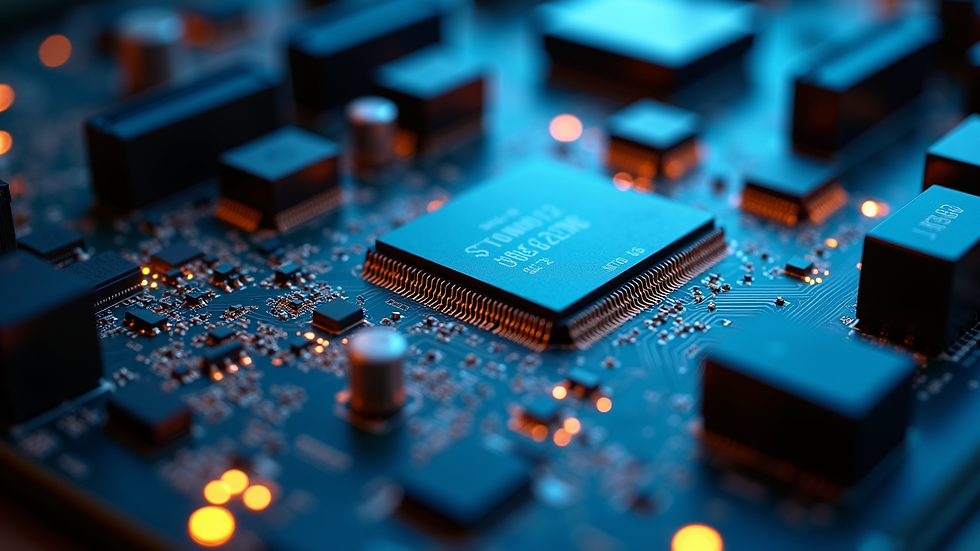Mastering the Essentials of CPU Architecture
- thecomputerscience4
- Aug 5
- 3 min read
Updated: Aug 14
Understanding the core concepts behind CPU design principles is crucial for anyone interested in how computers work at a fundamental level. The central processing unit (CPU) is the brain of any computing device, responsible for executing instructions and managing data flow. This article will guide you through the essential aspects of CPU design, breaking down complex ideas into clear, actionable insights.
The Importance of CPU Design Principles
CPU design principles form the foundation for creating efficient, powerful processors. These principles dictate how a CPU processes instructions, manages memory, and communicates with other components. Good design ensures that a CPU can perform tasks quickly while consuming minimal power and generating less heat.
Some key design principles include:
Instruction Set Architecture (ISA): Defines the set of instructions the CPU can execute.
Pipelining: Allows multiple instructions to be processed simultaneously at different stages.
Parallelism: Increases performance by executing multiple operations concurrently.
Cache Design: Improves speed by storing frequently accessed data close to the CPU.
Power Efficiency: Balances performance with energy consumption.
By mastering these principles, designers can create CPUs that meet the demands of modern applications, from smartphones to supercomputers.

Key Components in CPU Design Principles
To understand CPU design principles, it is essential to know the main components that make up a CPU:
Arithmetic Logic Unit (ALU): Performs mathematical and logical operations.
Control Unit (CU): Directs the operation of the processor by interpreting instructions.
Registers: Small, fast storage locations for temporary data.
Cache Memory: Stores frequently used data to speed up processing.
Buses: Pathways that transfer data between CPU components and memory.
Each component plays a specific role in ensuring the CPU operates efficiently. For example, the ALU handles calculations, while the control unit manages instruction flow. Registers provide quick access to data, reducing the time needed to fetch information from slower memory.
Understanding how these components interact helps in grasping the overall design principles that make CPUs effective.

What is the CPU architecture?
CPU architecture refers to the design and organisation of a CPU's components and how they work together to execute instructions. It defines the structure, behaviour, and capabilities of the processor. Different architectures can significantly impact performance, power consumption, and compatibility with software.
There are several types of CPU architectures, including:
CISC (Complex Instruction Set Computing): Features a large set of instructions, some of which can perform complex tasks in a single command.
RISC (Reduced Instruction Set Computing): Uses a smaller set of simple instructions, allowing for faster execution and easier pipelining.
VLIW (Very Long Instruction Word): Executes multiple operations in a single instruction cycle by packing them together.
EPIC (Explicitly Parallel Instruction Computing): Designed to exploit instruction-level parallelism explicitly.
Each architecture has its advantages and trade-offs. For example, RISC architectures are popular in mobile devices due to their power efficiency, while CISC architectures are common in desktop and server CPUs for their versatility.
For a deeper dive into cpu architecture, exploring resources like The Computer Science Tutor can provide comprehensive explanations and examples.

Practical Applications of CPU Design Principles
Understanding CPU design principles is not just theoretical - it has practical implications in various fields:
Software Development: Knowing how CPUs process instructions helps developers write more efficient code.
Hardware Engineering: Engineers use design principles to create CPUs that meet specific performance and power requirements.
Embedded Systems: Designing CPUs for devices like IoT gadgets requires balancing size, power, and functionality.
Gaming and Graphics: High-performance CPUs with advanced design principles enhance gaming experiences and graphics rendering.
For example, software developers can optimize programs by minimizing complex instructions that slow down execution on certain architectures. Hardware engineers might focus on improving cache design to reduce latency in data access.
By applying these principles, professionals can improve system performance and user experience across many technology sectors.
Future Trends in CPU Design Principles
The landscape of CPU design is constantly evolving. Emerging trends include:
Heterogeneous Computing: Combining different types of cores (e.g., high-performance and energy-efficient) in one CPU.
Quantum Computing: Exploring new architectures based on quantum mechanics principles.
Neuromorphic Computing: Designing CPUs that mimic the human brain's neural networks.
3D Chip Stacking: Increasing performance and reducing latency by stacking multiple layers of circuits.
These innovations aim to overcome current limitations in speed, power consumption, and scalability. For instance, heterogeneous computing allows devices to switch between cores depending on the task, optimizing energy use without sacrificing performance.
Staying informed about these trends is essential for anyone involved in technology development or interested in the future of computing.
Mastering the essentials of CPU design principles opens the door to understanding how modern computing devices operate. Whether you are a student, developer, or enthusiast, grasping these concepts provides a solid foundation for exploring more advanced topics in computer science and engineering.



Comments